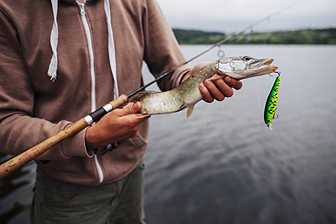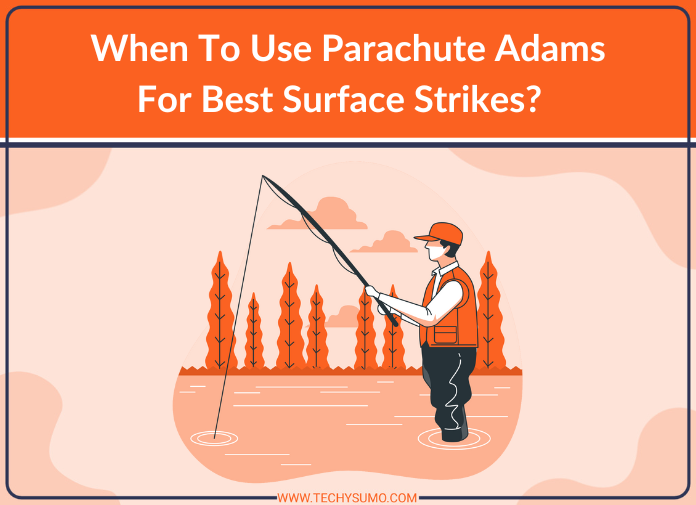Parachute Adams, a common item in an angler’s box, has gained its deserved place as one of the most versatile and effective patterns for surface strikes. Known for its ability to fool even the most cautious fish, this dry fly works wonders across a range of hatches.
But it is good to know when to use it to unleash its full potential.
Having said that, let’s take a look at the conditions, techniques, and timing that will make the Parachute Adams your go-to choice for the perfect surface strike.
Table of Contents
What Makes the Parachute Adams So Effective?

The Parachute Adams is not just another fly; it is a game changer for anglers looking to imitate the delicate action of mayflies on the surface of the water.
With a rich history and a long-standing reputation for being one of the most reliable patterns, this dry fly is famous for its unparalleled versatility and effectiveness.
Also Read
Let’s discuss why it is a must-have in each fly fisher’s kit.
Versatility Across Hatches and Water Types
When casting into fast-flowing riffles or still, glassy water conditions, the Parachute Adams excels across a wide variety of environments. It works well with many mayfly hatches, whether it is large mayflies of spring or the tiny midges of winter.
The versatility is not limited to any specific season, thus making it a great choice throughout the year, for beginners and seasoned anglers. Paired with a quality fly fishing combo, the Parachute Adams outshines in any weather, be it rough streams or calm lakes.
High Visibility Due to Parachute Post
The most noticeable feature of Parachute Adams is its high visibility, courtesy of the unique parachute post. This post makes it easy to track the fly, whether it’s bright sunlight or overcast conditions, enabling anglers to maintain accuracy in their casts.
Its white or vividly colored post serves as a beacon, standing out against the water, and making it easy to identify the fly even in busy or choppy waters.
Imitates a Wide Range of Mayflies and Midges

The magic of the Parachute Adams is that it can imitate a number of insect species. It’s a master of deception, bearing a close resemblance to mayflies and midges during various stages of their life cycle.
Whether you are imitating the duns or spinners of mayflies or the numerous smaller midges that frequent colder waters, this fly can do it all. Its universal appeal makes it a go-to option for targeting trout and other fish species that feed on surface insects.
Ideal Conditions for Surface Strikes
When it comes to surface strikes, timing is everything. Knowing the ideal conditions that make the Parachute Adams a lethal weapon in your fly fishing arsenal can make all the difference between a successful outing and a day of empty hooks.
Best Seasons: Spring and Fall for Mayfly Activity

Spring and fall are the prime seasons for surface strikes, especially when mayflies dominate the water. As temperatures begin to warm in spring, mayflies hatch in droves, and trout are eager to take advantage of this feast.
The crisp air and cooler waters of fall offer another window, with mayflies once again filling the skies and tempting trout to surface. These seasons, with their steady hatches, create the perfect environment for the Parachute Adams to shine.
Its ability to mimic these mayflies makes it a go-to fly during these months.
Optimal Weather Conditions: Overcast vs. Sunny
Cloudy skies can be your best friend when fishing for surface strikes. Overcast weather softens the light and reduces glare on the water, making it easier for trout to spot emerging insects.
When the sun’s harsh rays are hidden behind the clouds, the trout are more likely to rise to the surface in search of a meal. While sunny days can also produce surface action, overcast conditions often trigger more consistent strikes, especially during hatches.
The Parachute Adams, with its high visibility and lifelike presentation, thrives under these conditions, giving you the perfect edge.
Time of Day: Early Morning and Dusk
Trout are most active during the quiet hours of early morning and the fading light of dusk. These times are when mayflies hatch in abundance, and trout are most likely to rise for their meal.
The early morning mist on the water can create a magical atmosphere, as trout break the surface to feast on insects. Similarly, as dusk settles in, the cool air and fading light encourage a final feeding frenzy before night falls.
During these key times of day, the Parachute Adams performs its best, attracting those surface strikes that make every angler’s heart race.
Matching Hatch with the Parachute Adams
The key to unlocking the full potential of the Parachute Adams lies in understanding the delicate balance between the insects on the water and the fish’s feeding habits.
Identifying Active Insect Life on the Water

To truly master the art of matching the hatch, start by carefully observing the water’s surface.
Look for signs of active insect life, whether it’s mayflies gently skimming the surface or the occasional rise of a trout.
Notice the shape, size, and color of the insects; these are your clues to selecting the perfect fly. Often, the first signs of a hatch are subtle, with insects drifting in the current and the occasional splash as a trout emerges for its meal.
When to Choose a Parachute Adams Over Other Patterns
The Parachute Adams excels in a wide range of hatches, especially when mayflies and midges are present. If you spot insects on the water with upright wings, delicate bodies, and a slow, almost drifting motion, the Parachute Adams is likely your best bet.
It’s perfect when the hatch is abundant, but the fish are picky. When other patterns fail, the Parachute Adams steps in as a reliable, versatile choice for a variety of hatches.
Size Selection Tips Based on Local Hatch Activity
Size matters when selecting your Parachute Adams. During spring and fall, when mayflies are larger, opt for a larger size (14-16), matching the size of the insects you observe.
For smaller midges or tiny mayfly species, go for a size 18 or 20. Always adjust based on what you’re seeing in the water, and don’t be afraid to change sizes if the fish seem hesitant.
Let the Parachute Adams Lead the Strike
The Parachute Adams is a true testament to versatility and timing. Whether you’re targeting a spring mayfly hatch or a winter midge swarm, this fly consistently delivers when matched with the right conditions.
Remember, patience and precision often lead to the most rewarding surface strikes. Let the Parachute Adams guide your fly fishing journey, and with each cast, trust that success is just one perfect presentation away.
Keep learning, keep casting, and let the strikes come to you.






